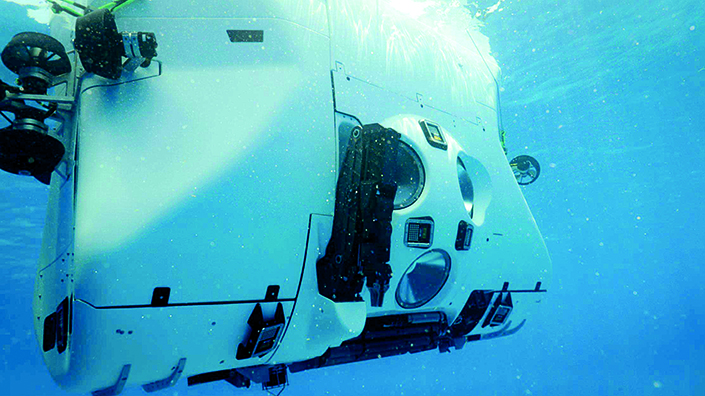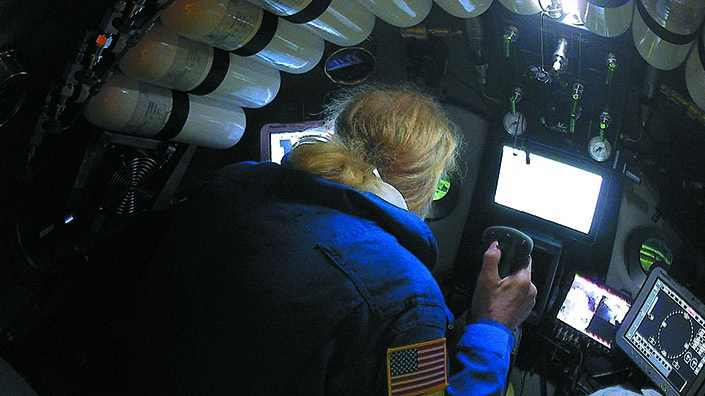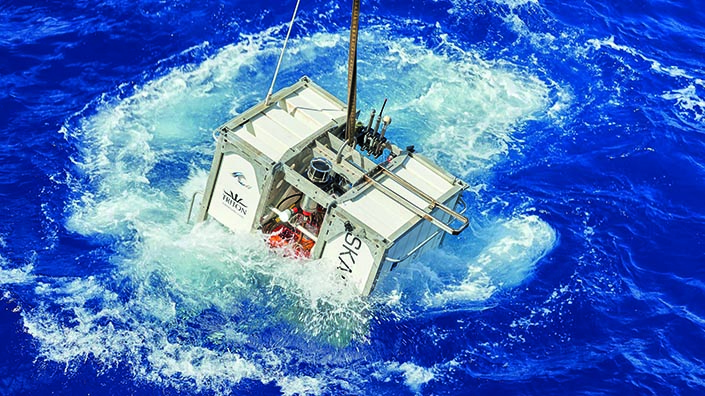The very deepest spot within it is the eastern pool of a valley called Challenger Deep, lying at 10,928m below sea level. It was here, in April 2019, that American private-equity millionaire Victor Vescovo achieved the deepest dive made by any human in history. It was part of his now completed mission – called the Five Deeps Expedition – to visit the deepest points of the world’s five oceans.
Victor’s vessel was a submarine called DSV Limiting Factor, a craft he had specially designed and built by Florida-based company Triton Submarines. “This submarine and its mother ship took marine technology to an unprecedented new level by diving – rapidly and repeatedly – into the deepest, harshest area of the ocean,” he said after returning to the surface. “We feel like we have just created, validated and opened a powerful door to discover and visit any place, any time, in the ocean – which is 90% unexplored.”
DSV Limiting Factor (or LF, as it’s known for short) is, like its mother ship DSSV Pressure Drop, named after fictional spacecraft from the sci-fi novels of the late Scottish author Iain M Banks. It’s an astounding piece of engineering. Designed by Triton’s British engineer, John Ramsay, it measures 4.6m long, 1.9m wide and 3.7m high, resembling some sort of giant suitcase rather than a traditional cylindrical submarine.
Much of its bulk is taken up by buoyancy foam, made of tiny glass spheres suspended in polymer resin. Triton assigned its most high-tech craft the model number 36000/2 (36,000 being the maximum depth in feet it can dive to and two being the number of occupants it can accommodate).
Titanium hull
Said occupants access the submarine via a hatch on the top before climbing down into the spherical pressure hull, forged from 90mm-thick titanium, with room inside for two people to sit comfortably on leather seats. From here, the pilot directs the vehicle using a joystick and a touchscreen, viewing the alien world outside through three 200mm-thick conical viewports made of acrylic.
The total weight of the sub – with submariners aboard – is around 11,700kg, fairly light for a submersible designed to withstand the crushing pressure at 11,000m below sea level. Its main lithium-polymer battery provides 65kWh of power, while a set of 10 electric thrusters allow it to move in all directions at a speed up to three knots. It can operate for up to 16 hours at a time. Ten external LED lights, each with 16,000 lumen, ensure the occupants have a great view of their surroundings, even in the darkest ocean depths where sunlight cannot penetrate. A robotic arm is used to collect samples and do experiments.

A robotic arm was used to collect samples (Credit: The Five Deeps Expedition)
Triton, based in a town on Florida’s Atlantic coast called Sebastian, manufactures 10 different models of submarine for deep-sea exploration, with depth ranges of between 300m and 11,000m. Ramsay, who is based the other side of the Atlantic, in a Devon village called Meavy, designed all but one of them.
The LF is the most advanced, by a country mile. Its titanium pressure hull was forged and machined in the US, while the components were manufactured in the US, the UK, Germany, Spain and Australia.
Unusually for a deep-sea submersible, the two hemispheres of the pressure hull are bolted together rather than welded. Ramsay says many of his peers in submarine engineering warned him against using bolts, worried the seal between the hemispheres wouldn’t hold at extreme depths. But he and the company’s co-founder and president, Patrick Lahey, were convinced a combination of bolts and precisely machined contact surfaces was the best option. They both agreed that welding would pose too many risks.
“The titanium hemispheres are machined to within half a millimetre,” Ramsay explains. “They’re so incredibly precise. If you’re then going to weld them together, you’re throwing a whole load of heat into the equation, which changes the properties of the titanium, causing it to warp. We were adamant we were going to eliminate that risk.”
Sealed by pressure
They knew that when the LF was thousands of metres down, the external pressure of seawater would clamp the two hemispheres together, tightening the seal even further. “The seals between the hemispheres are actually low-pressure seals, designed to work at depths up to 1,000m,” Ramsay adds. “Below that level the actual seal is generated by having metal on metal, forced together, which creates its own seal.”
One of the most impressive achievements of the LF, Ramsay says, is its compactness. “The problem with submarines is, the bigger they get, the heavier they get,” he says. “And the heavier they get, the more space they take up on the deck of the mother ship; and the bigger the handling system you need to take them in and out of the water. Everything grows exponentially in size.”
He believes his LF submarine is lighter even than Deepsea Challenger, the vehicle that Canadian film director James Cameron used to visit the Mariana Trench in 2012. “But that was minuscule, with room for just one person in the foetal position,” Ramsay adds. “Whereas, in the LF, two people can sit extremely comfortably side by side.”
Ballast devices
The other major engineering achievement is the LF’s ballast system. Most submarines carry ballast tanks containing compressed air at up to 300bar, the equivalent of water pressure at 3,000m down. Lower down than 3,000m, however, these air cylinders are likely to collapse – not very useful for Vescovo’s voyage into the abyss. Instead, Ramsay incorporated three different ballast devices into his sub.
First is a ballast control tube containing twenty 5kg weights, used to submerge the submarine to the ocean floor. These are released one at a time until the LF’s descent slows and the craft settles into position just above the seabed. Ramsay explains how, when the submarine reaches diving depth, it needs to be slightly positively buoyant so that it floats along just above the seabed. This allows the pilot to make small thrusts downwards in order to stay at the same depth. “Thrusting in a downwards direction doesn’t stir up the seabed,” Ramsay says. “If you have to thrust upwards to stay in place, though, it fires a jet of water downwards and stirs up the seabed so you can’t see a thing. It’s unbelievable how long it takes for the silt to settle after it has been stirred up. It can take hours.”

Victor Vescovo pilots the sub (Credit: The Five Deeps Expedition)
The second ballast device is a set of huge steel weights on the bottom of the submarine, secured in place by electro-magnets. This is a failsafe system which – in case of power failure or if the pilot loses consciousness – automatically triggers the release of the weights, causing the craft to return to the surface.
Finally there is the air ballast which kicks in once the LF returns to the surface. This, Ramsay explains, uses a “clever combination of one-way valves” to increase the buoyancy and ensure the submarine remains with its top section above the sea surface once the mission is complete. “Without this extra buoyancy, you would reach the surface and the submarine would constantly be dipping up and down,” Ramsay adds. “A wave would come, lift it up, and then the LF would dive back down below the surface.” All this bobbing around would make it extremely difficult for the occupants to exit the hatch, or for divers to locate the craft; and very dangerous when the mother ship attempted to winch the submarine on board.

One of three landers that supported LF and did extra scientific tasks (Credit: The Five Deeps Expedition)
Given his intimate knowledge of the submarine’s engineering, it was only right that Ramsay himself should have been offered a trip to the bottom of the Mariana Trench. His dive, piloted by his company boss Patrick Lahey, took place seven days after Vescovo had set the new depth record, and saw the two men visiting Challenger Deep’s slightly less deep central pool. They spent just over three hours on the sea floor.
“I think Patrick and I are the only people who have dived into the central pool,” Ramsay says of his experience, during which they captured geological and biological samples.
The ocean surroundings at that depth are like an alien planet. Descending from the ocean surface, the LF passes through several zones. First, from the surface down to around 200m, is the sunlight (or epipelagic) zone. This is followed by the twilight zone (200 to 1,000m), the midnight zone (1,000 to 4,000m), the abyssal zone (4,000m to a depth where much of the ocean floor lies), and finally the hadal zone (beyond depths of 6,000m), named after Hades, the underworld.
Sea life at great depths
Ramsay describes the sea life he observed down in the hadal zone. “Mostly anemones and little shrimp-like things; little white creatures scampering around the seabed.”
Not the most exciting beings, he admits, but he was surprised at just how much life there was down there. “You see a lot more than if you were swimming along the beach in Devon, which I do quite a lot,” he adds.

Sub designer John Ramsay (Credit: The Five Deeps Expedition)
The LF has been busy since it completed Vescovo’s Five Deeps Expedition. It has visited the wreck of the Titanic, for example. In February this year Vescovo dived in it again, this time to the deepest point in the Mediterranean – Calypso Deep – accompanied by Prince Albert II of Monaco.
Now the craft is up for sale. It might have a future in scientific exploration. It might be used for documentaries or feature films, or to visit sunken shipwrecks. It might simply ferry wealthy tourists to the bottom of the ocean.
But whoever ends up buying it will need pockets as deep as the ocean floor. The asking price is $48.7m.
Want the best engineering stories delivered straight to your inbox? The Professional Engineering newsletter gives you vital updates on the most cutting-edge engineering and exciting new job opportunities. To sign up, click here.
Content published by Professional Engineering does not necessarily represent the views of the Institution of Mechanical Engineers.